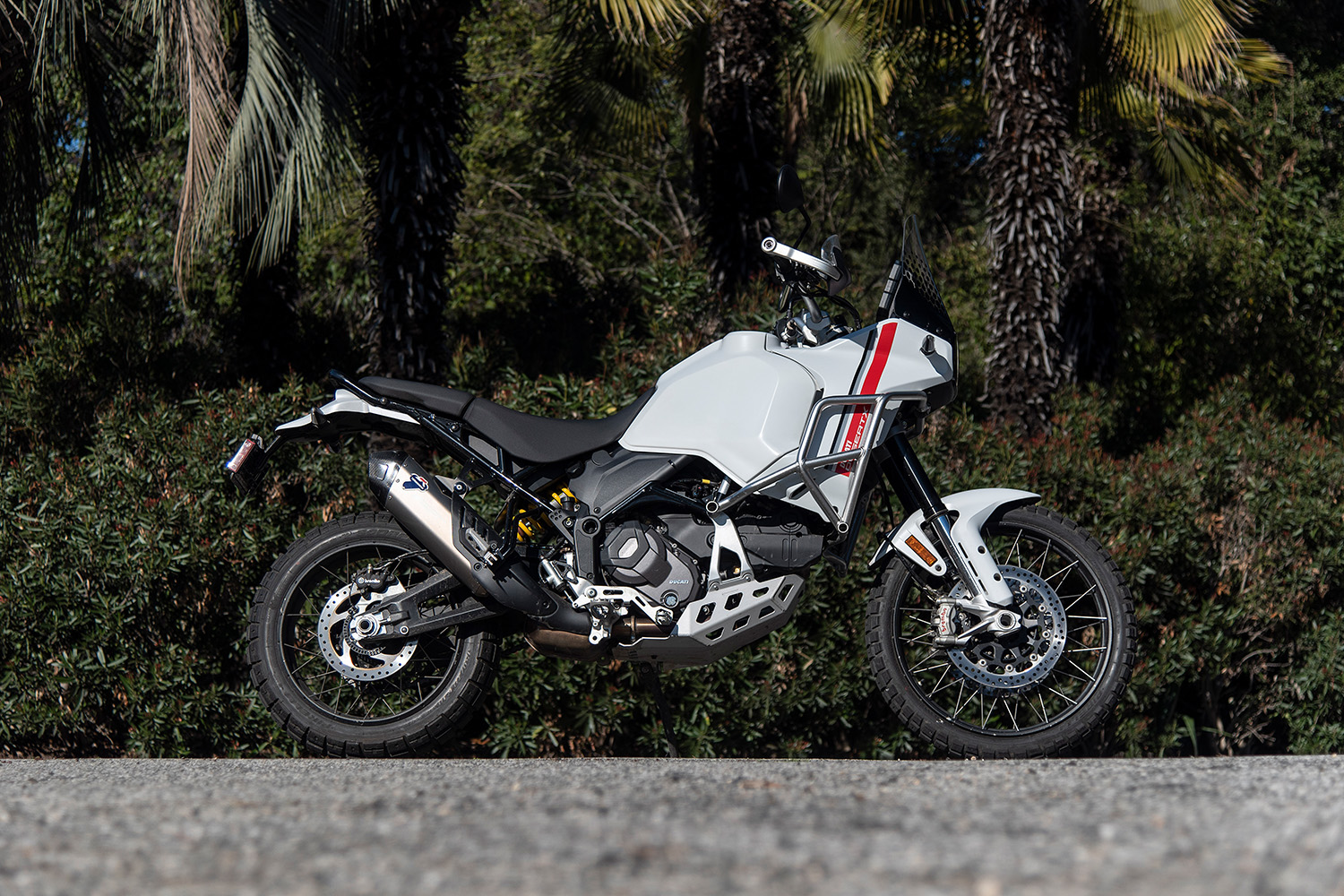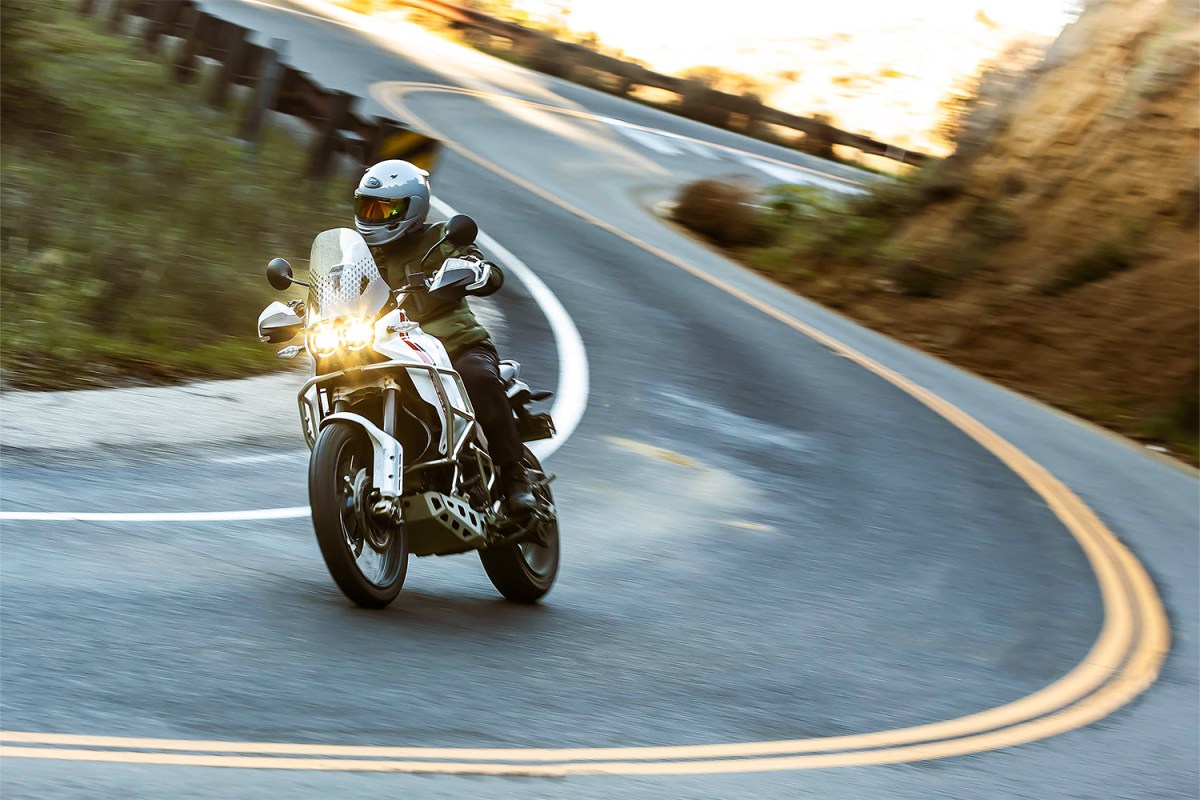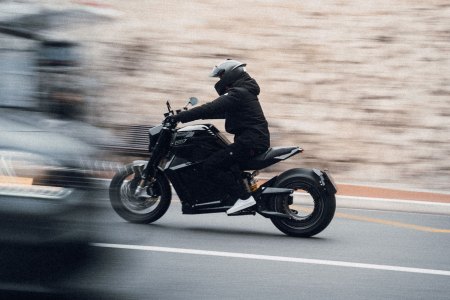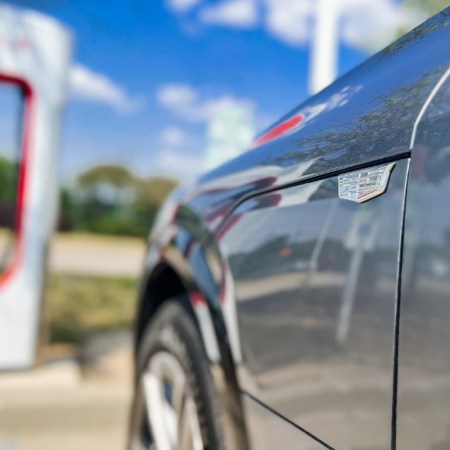For the vast majority of its 75 bike building years, Ducati has veered away from terrain. While contemporary models like the Multistrada and Scrambler flirt with trail friendliness, most of the Italian’s efforts have focused on racetracks and roadways, leaving the serious dirty work to foes like BMW and KTM.
Making an abrupt about-face is the DesertX, a burly Ducati off-roader powered by a very Ducati 937cc L-twin engine — a version of the mill found in the Hypermotard, Multistrada V2, and Supersport that’s been tuned for off-road duty. The powertrain packs the brand’s signature Desmodromic valves, lending it a respectable 10,000 rpm redline. More critically, this is the first Ducati to feature 21-inch front and 18-inch rear wheels, all the better for rolling over raw earth with. Bolstering the off-road capability is a massive 9 inches of front suspension travel and 8.6 inches at the rear.
Because the DesertX’s off-road prowess has been recounted ad nauseum, we at InsideHook decided to take another tack. Rather than take Ducati’s ruggedest ride through gravel and sand, we tackled a different kind of obstacle: the banged up, torn down roads and freeways of time-ravaged Los Angeles in winter. Who needs infrastructure when you’ve got an apocalypse grade motorcycle?
Parked in the urban jungle, the DesertX looks like a time traveler from an old school Dakar Rally trimmed with subtle nods to modernity. The body, particularly the fairing and twin round headlights, recall the Cagiva Elefant which earned the manufacturer its inaugural win at Paris-Dakar Rally in 1990, and again in 1994. The lineage is legit: Cagiva owned Ducati back in the day, and the winning bike was powered by a 904cc Ducati L-twin with desmodromic valves, which scores valuable cred among crusty dirtbike fanatics.

The modern day DesertX is endowed with a bit more grunt than the roadgoing version of the bike that won Dakar (and, incidentally, produced only 68 horsepower). This time around output peaks at 110 horsepower and 68 lb-ft. Those numbers remain modest compared to some of the Ducati’s rascaliest rides like the four-cylinder Multistrada, which churns a superbike-like 170 horsepower. But these figures are almost exactly where you want to be when tackling tasks over dicey surfaces that require absolute skill and the utmost control. This is not a Texas Mile/Sun Valley Tour de Force top speed machine; the DesertX is more like a giant trials bike that’s also setup for long distance riding thanks to options like heated grips, an auxiliary gas tank, and all manner of removable luggage.
DesertX takes a commanding stance thanks to its daddy long legs suspension and knobby tires, which can make it look like a daunting bit of kit to swing a leg over. My tester rolled on tubeless Pirelli Scorpion Rally STR rubber, whose large treadblocks make them suitable for proper off-roading — and as I would soon find out, surprisingly well-adapted for inclement weather. Though not as sketch as the wilds of Senegal, LA’s rain-soaked streets still pose a substantial threat to the delicate task of keeping the shiny side up, especially after a long absence of rain when slippery oils and residues build up on the road.
Fire up the DesertX, and the big twin produces some very Italianate sounds. Though perhaps not as loud as you might expect, especially considering it’s equipped with the optional titanium Termignoni exhaust — a $3,075 option — there’s still a definitively Ducati aspect to the sound. Long live internal combustion. The view over the windshield is presided by a vertically-oriented 5-inch TFT display, a window into the bike’s techy features which can be managed via the switchgear on the left grip (sorry folks, if you’re tapping the display to control it, you’ll be SOL since it’s not a touchscreen). It does access quite a few rider settings, including adjustable engine output and braking, wheelie control, lean-sensitive ABS, and more. Those parameters can be configured via pre-set themes like “Rally” or “Road,” and visualized using slick graphical representations.
Verge Built a Groundbreaking Motorcycle. Is That What Bikers Want?
Marko Lehtimaki, co-founder of the EV startup, talks about being inspired by Apple and Tesla, expanding interest in motorcycles and completely rethinking bike designWhile all manner of hard saddlebags, topcases, extended windshields and skidplates are available as accessories, one button on the switchgear all but made my rainy SoCal day: the power button for the heated grips. Shielded by handguards and warmed by heating elements, my gloved hands thankfully avoided the soul sucking freeze that can lead to numbness and general misery. Happy hands, happy rider. The DesertX’s upright posture lends it an SUV-like view of the road, making it easy to scan traffic ahead and anticipate the inevitable slowdown. The handlebars are a tad wide for lane-splitting, but maneuverability is sky high thanks to lightweight spoked wheels which enable sharp cuts and abrupt weaves when avoiding the inevitable inattentive driver. Despite its relatively low power, there’s enough oomph to squat the chassis and lift the front wheel, with thrust maintaining its pull thanks to a quickshift function which enables clutch-free upshifts and rev-matched downshifts. Brakes are also properly powerful, with Brembo four-piston front and twin-piston rears delivering excellent feedback. While the myriad settings work wonders at managing the bike’s electronic aids, navigating the menus can be cumbersome. There’s a learning curve to the interface and menu structure which can involve quite a bit of trial and error before figuring out how it all works. At least the six ride modes — Sport, Touring, Urban, Wet, Enduro, and Rally — are customizable.
The Ducati DesertX certainly looks like a lean, mean wilderness machine even when surrounded by skyscrapers. But my ultimate urban test came during a product launch ride for the new Arai Contour-X helmet, where I rode amidst a pack of delightfully foolhardy moto journalists. Surrounded by everything from superbikes to supermotos, the DesertX looks like a fish out of proverbial water. But here’s the rub: on Malibu’s gravel-strewn canyon roads, the DesertX feels like it was built precisely for the task of riding fast over these challenging stretches of road. Thanks to the nimble handling, the knobby Pirellis, the plush suspension, and the balanced combination between low-end torque and effective traction control, the DesertX negotiates these twisty roads like a boss. Don’t delude yourself and select Sport mode. In Urban or Wet settings, power is trimmed to 95 hp and throttle response is smoothed out, which helps maintain traction when accelerating out of corners. Play your cards right and you’ll hang with the fast guys; go a little aggro, and you might even find yourself near the front of the pack. It’s a refreshing reversal of the more-is-more ethos, one that rewards using the right tool for the job in its proper setup.
There are no doubt plenty of riders who will take their DesertXs off road, and I salute their use of a premium Italian machine for the often gritty, grimey task of tackling the great outdoors. Starting at $16,795, this Ducati can approach the mid-20s when equipped with all the farkles you’d want on an adventure-ready bike — a substantial sum for what is essentially a fancy enduro bike. While the DesertX’s off road capabilities are indeed capable of negotiating a variety of dirt-oriented crucibles, I’d argue that my real world experience on public roads makes me believe there are few machines I’d rather be piloting when chasing down a flock of rev-happy riders on a wet, winding canyon road.
This article was featured in the InsideHook newsletter. Sign up now.

























